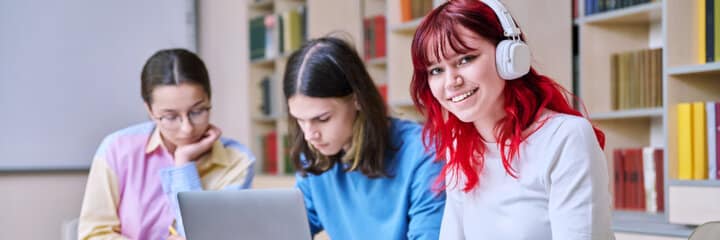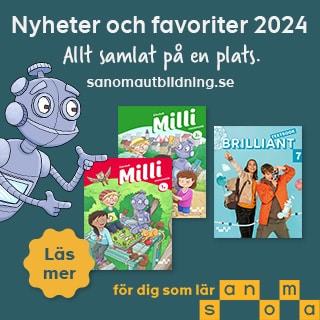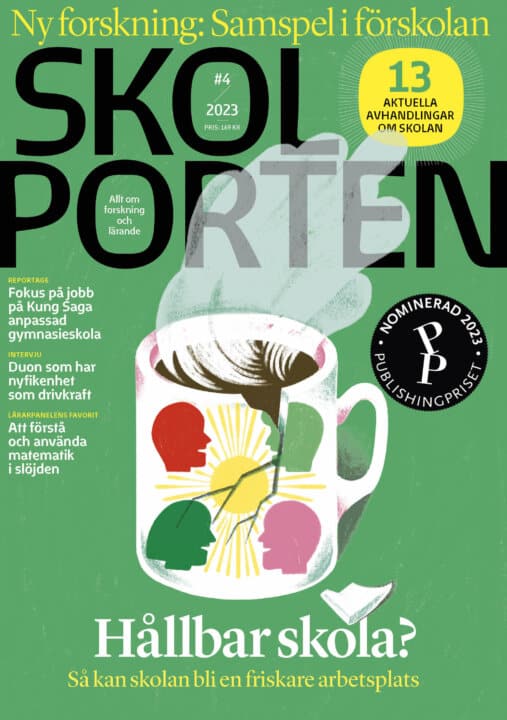Litteracitet i fem högstadieungdomars en-till-en-datorpraktiker
Eva Jacquet har i sin avhandling utforskat fem ungdomars datoraktiviteter i hemmet, i skolan och på andra platser.
Eva Jacquet
Professor Ria Heilä-Ylikallio, Åbo akademi Anna Slotte, Åbo akademi Anders Björkvall, Stockholms universitet
Professor Elise Seip Tönnesen, Universitetet i Agder, Norge
Åbo akademi
2016-06-08
Litteracitet i fem högstadieungdomars en-till-en-datorpraktiker
Litteracitet i fem högstadieungdomars en-till-en-datorpraktiker
Studien har fokus på fem högstadieungdomars dagliga bruk av sina en-till-en-datorer, med det övergripande syftet att undersöka litteracitet i deras en-till-en-datorpraktiker.
Teoretiskt förankras studien i New Literacytraditionen med ett ekologiskt perspektiv, i kombination med socialsemiotisk teori med ett multimodalt perspektiv. New literacy och det ekologiska perspektivet, uppmärksammar litteracitetspraktiker och plats samt sambandet dem emellan. Litteracitet ses som socialt förankrad, i konkreta situationer och i återkommande sociala praktiker. Den socialsemiotiska teorin och det multimodala perspektivet tas i bruk för textanalyserna. Metodologin benämns socialsemiotisk etnografi.
De etnografiska metoderna omfattar drygt två års fältarbete med deltagande observationer av de fem deltagarnas datoraktiviteter i hemmet, i skolan och på andra platser. Deltagarna har också genomfört egna självdokumentationer av sina datoraktiviteter. Deltagarna, en pojke och två flickor från Blåsippsskolan och två flickor från Vitsippsskolan, har valts för att spegla bredd vad gäller sociokulturell och socioekonomisk bakgrund. Vitsippsskolan är belägen i ett miljonprogramsområde med en mångkulturell prägel där de boende har lägre inkomster och utbildningsnivåer än de som bor i det villaområde där Blåsippsskolan ligger.
I studien framkommer att det föreligger en bred och djup variation i hur digital litteracitet framträder i deltagarnas en-till-en-datorpraktiker. Variationerna har koppling till erfarenheter i hemmet, boendemiljö, plats, personliga egenskaper och skolerfarenheter. Blåsippsdeltagarnas mer varierade datorbruk har koppling till de intressen de utvecklat i sina hem och boendemiljöer och till den datorpraktik som förekommer i skolan. Deras mer varierade datorbruk återspeglas vidare i deras bredare digitala litteracitetsrepertoarer och fler och mer varierade digitala litteracitetsförmågor.
Blåsippsdeltagarnas textproduktion är mer mångfasetterad, spänner över ett bredare ämnesfält och uppvisar en bredare palett av semiotiska resurser. I Blåsippsflickornas textproduktion kombineras fler texttyper och texterna är generellt längre. Blåsippsflickorna har utvecklat en textkultur som ligger nära skolans. För deras del finns tydliga länkar mellan skol- och självinitierade datoraktiviteter, medan övriga deltagare inte har lika stora möjligheter att länka och integrera självinitierade datoraktiveter i skolsammanhanget. Det tydliggörs också att Blåsippsflickorna kan förhålla sig till och anpassa sina texter till olika kommunikativa praktiker och mottagare. Vidare synliggörs att Blåsippsflickorna har eller tar ett relativt stort handlingsutrymme i skolpraktiken genom att de införlivar vissa kommunikativa praktiker som de utvecklat inom umgängespraktiken i skolpraktiken.
Tvärtemot förhoppningarna med en-till-en om att minska den digitala ojämlikheten har den ökat mellan dessa deltagare. Huruvida samma och likartade resultat gäller i det större perspektivet på ett mer strukturellt plan, kan inte studien ge besked om endast påtala att är det angeläget att undersöka.
På en rad olika sätt framkommer att Vitsippsdeltagarna i skolan inte får likvärdiga möjligheter att utveckla sin digitala litteracitet som Blåsippsdeltagarna. Utifrån likvärdighetsperspektiv har skolan ett kompensatoriskt uppdrag. Det framkommer med största tydlighet i studien att det inte räcker att satsa på en-till-en-projekt för att motverka digital (o)jämlikhet och uppnå de mål som formuleras för skolans digitalisering. Skolan behöver parallellt med tekniksatsningar utveckla en didaktik som legitimerar och kompenserar elevers olika förutsättningar. Att skolan fungerar kompensatorisk har vidare inte endast betydelse för dessa deltagare utan för samhället i stort, för att borga för ett sammanhållet, öppet och demokratiskt samhälle.
Abstract in English
The study focuses on five lower secondary school pupils’ daily use of their one-toone computers, the overall aim being to investigate literacy in this form of computing. Theoretically, the study is rooted in the New Literacy tradition with an ecological perspective, in combination with socio-semiotic theory in a multimodal perspective. New Literacy in the ecological perspective focuses on literacy practices and place/space and on the links between them. Literacy is viewed as socially based, in specific situations and in recurring social practices. Socio-semiotic theory embodying the multimodal perspective is used for the text analysis. The methodology is known as socio-semiotic ethnography. The ethnographic methods encompass just over two years of fieldwork with participating observations of the five participants’ computing activities at home, at school and elsewhere. The participants, one boy and two girls from the Blue (Anemone) School and two girls from the White (Anemone) School, were chosen to reflect a broad spectrum in terms of sociocultural and socioeconomic background.
The study shows the existence of a both broad and deep variation in the way digital literacy features in the participants’ one-to-one computing. These variations are associated with experience in relation to the home, the living environment, place, personal qualities and school. The more varied computer usage of the Blue School participants is connected with the interests they developed in their homes and living environments and in the computing practices undertaken in school. Their more varied usage of the computer is reflected in their broader digital literacy repertoires and their greater number and variety of digital literacy abilities.
The Blue School participants’ text production is more multifaceted, covers a wider range of subjects and displays a broader palette of semiotic resources. It also combines more text types and the texts are generally longer than those of the White School participants. The Blue School girls have developed a text culture that is close to that of the school. In their case, there is clear linkage between school-initiated and self-initiated computing activities, while other participants do not have the same opportunities to link and integrate self-initiated computing activities into the school context. It also becomes clear that the Blue School girls can relate and adapt their texts to different communicative practices and recipients. In addition, the study shows that the Blue School girls have some degree of scope in their school practice as a result of incorporating into it certain communicative practices that they have developed in nonschool contexts.
Quite contrary to the hopes expressed that one-to-one computing would reduce digital inequality, it has increased between these participants. Whether the same or similar results apply in a larger perspective, on a more structural level, is a question that this study cannot answer. It can only draw attention to the need to investigate the matter.
The study shows in a variety of ways that the White School participants do not have the same opportunity to develop their digital literacy as the Blue School participants. In an equivalence perspective, schools have a compensational task to perform. It is abundantly clear from the study that investing in one-to-one projects is not enough to combat digital inequality and achieve the digitisation goals established for school education. Alongside their investments in technology, schools need to develop a didactic that legitimises and compensates for the different circumstances of different pupils. The compensational role of schools in this connection is important not only for the present participants but also for the community at large, in that it can help to secure a cohesive, open and democratic society.
Relaterade länkar

Undervisa i artificiell intelligens
 Gy–Vux
Gy–Vux 







